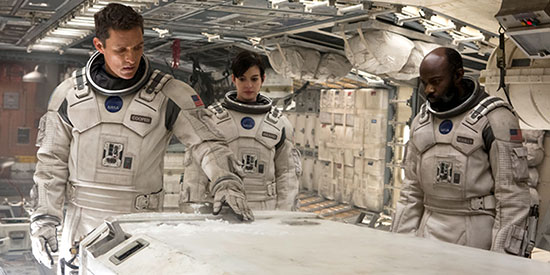«Interstellar»: science and licence
We talk to astrophysicist José Antonio Font about the latest film by Christopher Nolan

«Cinema and Science are not incompatible worlds». This was the title of Manuel Moreno Lupiañez’s article included in Mètode’s monograph «Science Frames», which dealt with the relationship between science and cinema. The frequent slip-ups, ever present in blockbusters, and the inaccuracy with which science and technology are portrayed may cause the impression that science and cinema are two incompatible and antagonistic worlds. But, is this a particular problem that only affects this area of knowledge? Or can we draw similar conclusions if we analyse the way history, anthropology and legal sciences, for example, are portrayed? For José Antonio Font Roda, PhD in Physics, specializing in astrophysics, and professor of the University of Valencia, «if a legal expert analyses a film that deals with trials and lawyers will most likely draw the same conclusion, that law and cinema are two incompatible worlds».
«”Interstellar” contains a good number of scientific issues which naturally make it very interesting for those of us who professionally research relativity and gravitation» (J. A. Font)
One of the most frequently explored themes in science fiction in cinema is the exploration and conquest of space. As Javier Memba explains in Science Fiction Movies’ New Era (1971-2011) (T & B Editores, 2011), «after 2001: A Space Odyssey, science fiction is all about space operas. That is, films whose action takes place entirely in outer space». In recent weeks, a film that fits within this profile has been shown in hundreds of cinemas: Interstellar. Christopher Nolan’s work is the focus of our conversation with José Antonio Font. For the astrophysics specialist, the film «contains a good number of scientific issues which naturally make it very interesting for those of us who professionally research relativity and gravitation». Although science plays an important role within the film, José Antonio Font points out that fiction is still more present. As an example, the presence of a supermassive black hole in the vicinity of Saturn, Font claims, «is pure fiction». «Likewise, the existence of wormholes through which to travel is more than doubtful, because their creation involves a change in the spatial topology in the space-time continuum. In fact, our current understanding of nature denies their very existence».

Warner Bros
«Having a scientific advisory board to make films is certainly a good idea and, in “Interstellar”‘s, case it was key to achieve an excellent final product» (J. A. Font)
José Antonio Font, however, does not want to refer to them as inaccuracies, but as «poetic license that provides the plot with some sense of coherence». Inaccuracies would be the existence of ice in clouds in the atmosphere of one of the planets the astronauts visit; the absence of colours in the disk around the black hole, when it should be showing the Doppler shift of the electromagnetic spectrum either in reddish or bluish hues; or the hypothetical presence of habitable planets near the accretion disk, a structure that emits X-rays. In turn, José Antonio Font says Interstellar has many successes, specifically four: crossing the event horizon of a black hole; the representation of rotating supermassive black holes; the gravitational time dilation and giant waves on the planet Miller. On crossing the event horizon of a black hole, Font points out that «this is always possible. If the black hole, however, has a similar mass to the Sun, the astronaut cannot survive the process. If, on the contrary, the hole is a supermassive black one, the astronaut experiences nothing special from the gravitational point of view and survival is possible».
He adds, «the readers interested in exploring the explanation for each and every one of the physics concepts discussed in Interstellar are in luck, because Kip Thorne himself, scientific advisor to the film as well as executive producer, has just published a popular science book in which all these explanations are provided». The book’s title is The Science of Interstellar (WW Norton & Company, 2014), but it seems that an earlier work by the same author, Black Holes and Time Warps: Einstein’s outrageous legacy (WW Norton & Company, 1994) was the starting point for the film. Thorne and Nolan have worked together in this production, «linking the scientific accuracy of the former in the description and visualization of the space-time of a black hole with the latter’s proficient film-making skills, which are undeniable in his use of impressive visual images and his narrative style» says José Antonio Font. «Having a scientific advisory board to make films is certainly a good idea and, in Interstellar’s case it was key to achieve an excellent final product».

Warner Bros
«At the heart of the film there is a message of deep concern regarding the survival of our species» (J. A. Font)
When speaking of film and science, it is also interesting to study the way scientists are portrayed: generally male and true to some stereotypes such as «the mad scientist», «the Sorcerer’s Apprentice» or «the adventurous and heroic martyr». Jordi José explained it in «Scientists at 24 frames a second». Interstellar, however, avoids stereotypes, as José Antonio Font claims, except on some bizarre occasions, «there is a brief climax in which Murphy, a scientist, with great joy starts shouting “Eureka!” and acts eccentrically throwing the sheets with all her calculations in the air. This scene exemplifies the cliché of the mad scientist in all its glory». In Interstellar scientists are not only men. Female characters are very active in the film, including the aforementioned Murphy Cooper and the astronaut Amelia Brand, key figures in the development of the plot and its outcome.

Warner Bros
But beyond the use of ideas and concepts taken from the theory of general relativity; beyond successes, failures and poetic license; or beyond the portrayal of science professionals, Nolan in this film portrays the contradictions of the human species, «simultaneously showing both its greatness and misery» according to José Antonio Font. «At the heart of the film there is a message of deep concern regarding the survival of our species, coupled with the fact that this seems to happen because we are able to leave our planet searching other habitable worlds. Although the message of the film is optimistic -overcoming difficulties to achieve the idyllic “happy ending” seems so an out of reach target that I can’t be nothing but pessimistic about it. If the solution is that an advanced civilization or a higher being places a wormhole near us, the future seems quite bleak for me». Finally, José Antonio Font states: «I am convinced that if there is a solution only scientific research and technology may lead to it. Perhaps that is the strongest conclusion that we should take with us».





